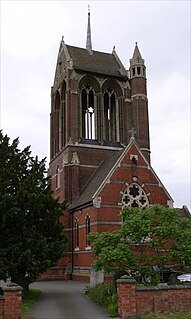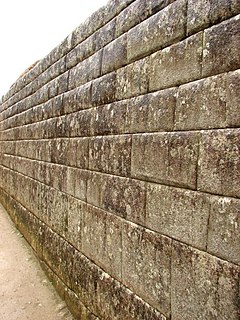
St Gregory's Church is a redundant Anglican church in Fledborough, Nottinghamshire, England. It is recorded in the National Heritage List for England as a designated Grade I listed building, and is under the care of the Churches Conservation Trust. The church stands at the end of a lane, in meadows near the River Trent.

St John the Baptist's Church is a redundant Anglican church in the village of Wakerley, Northamptonshire, England. It is recorded in the National Heritage List for England as a designated Grade I listed building, and is under the care of the Churches Conservation Trust. It stands in an elevated position overlooking the Welland Valley.

St Wilfrid's Church is a redundant Anglican church in the village of Low Marnham, 18.6 kilometres (12 mi) to the east of Edwinstowe, Nottinghamshire, England. It is recorded in the National Heritage List for England as a designated Grade I listed building, and is under the care of the Churches Conservation Trust.
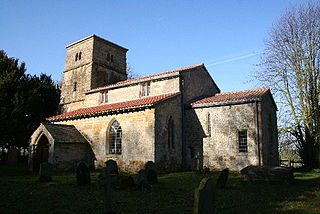
St Peter's Church is a redundant Anglican church in Kingerby, Lincolnshire, England. It is recorded in the National Heritage List for England as a designated Grade I listed building, and is under the care of the Churches Conservation Trust. The church stands in an isolated position opposite the grounds of Kingerby Hall.

St Nicholas' Church is a redundant Anglican church in the village of Feltwell, Norfolk, England. It is recorded in the National Heritage List for England as a designated Grade I listed building, and is under the care of the Churches Conservation Trust. It has a partly collapsed west tower, and is unusual in being broader than it is long, having two side aisles and no chancel.
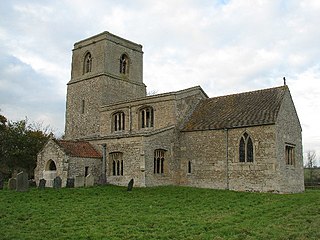
St Barbara's Church is a redundant Anglican church in the village of Haceby, Lincolnshire, England. It is recorded in the National Heritage List for England as a designated Grade I listed building, and is under the care of the Churches Conservation Trust. The church is situated some 8 miles (12.9 km) to the east of Grantham, about 1 mile (1.6 km) south of the A52 road. It has a double dedication to Saint Barbara and Saint Margaret.

St Peter's Church is a redundant Anglican church in the village of Normanby by Spital, Lincolnshire, England. It is recorded in the National Heritage List for England as a designated Grade I listed building, and is under the care of the Churches Conservation Trust. The church stands close to the former Roman road, Ermine Street, now the A15 road.

St Peter's Church is a redundant Anglican church in the village of Offord D'Arcy, Cambridgeshire, England. It is recorded in the National Heritage List for England as a designated Grade I listed building, and is under the care of the Churches Conservation Trust. The church stands adjacent to the East Coast Main Railway Line, overlooking the River Great Ouse.

St Denys' Church is a redundant Anglican church in the village of Little Barford, Bedfordshire, England. It is recorded in the National Heritage List for England as a designated Grade II* listed building, and is under the care of the Churches Conservation Trust. The church lies to the west of the village of Little Barford, overlooking the River Great Ouse, about 2 miles (3 km) south of St Neots.

St Botolph's Church is a redundant Anglican church near the village of Skidbrooke, Lincolnshire, England. It is recorded in the National Heritage List for England as a designated Grade I listed building, and is under the care of the Churches Conservation Trust. It stands in an isolated position in the Lincolnshire marshlands, about 7 miles (11 km) northeast of Louth, and to the west of the A1031 road.

St Mary the Virgin's Church is a redundant Anglican church in the civil parish of Wiggenhall St Germans, Norfolk, England. It is recorded in the National Heritage List for England as a designated Grade I listed building, and is under the care of the Churches Conservation Trust. The church stands at the end of a lane to the north of the village of Wiggenhall St Mary the Virgin, some 5 miles (8 km) south of King's Lynn. It is notable particularly for the quality of carving of its wooden fittings.

St Margaret's Church is a historic Anglican church in the village of Abbotsley, Cambridgeshire, England. It is recorded in the National Heritage List for England as a designated Grade II* listed building, and is under the care of The Churches Conservation Trust. The church stands in the centre of the village, to the south of the B1046 road.

St Mary's Church is a redundant Anglican church in the village of East Ruston, Norfolk, England. It is recorded in the National Heritage List for England as a designated Grade II* listed building, and is under the care of the Churches Conservation Trust. The church stands in an isolated position on the east side of the B1159 road, some 2 miles (3 km) north of Stalham. It is noted for its 15th-century painted and carved chancel screen.
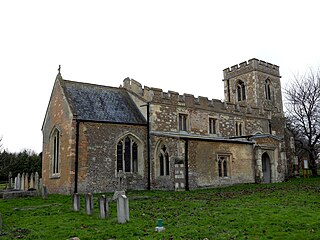
St George's Church, Edworth, is a redundant Anglican church in the village of Edworth, Bedfordshire, England. It is recorded in the National Heritage List for England as a designated Grade I listed building, and is under the care of the Churches Conservation Trust. Edworth is about 3 miles (5 km) southeast of Biggleswade, to the east of the A1 road.
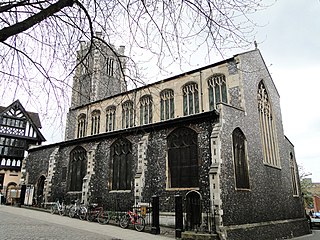
The Church of St John the Baptist, Maddermarket, is a redundant Anglican church in the city of Norwich, Norfolk, England. It is recorded in the National Heritage List for England as a designated Grade I listed building, and is in the care of the Churches Conservation Trust.

St Mary's Church is a redundant Anglican church in the village of Redgrave, Suffolk, England. It is recorded in the National Heritage List for England as a designated Grade I listed building, and is under the care of the Churches Conservation Trust. The church stands on a rise about 1 km east of the village.

St John the Baptist's Church is a redundant Anglican church in the village of Yarburgh, Lincolnshire, England. It is recorded in the National Heritage List for England as a designated Grade I listed building, and is under the care of the Churches Conservation Trust. The village lies away from main roads, some 5 miles (8 km) northeast of Louth.

St Andrew's Church is a redundant Anglican church in the village of Redbourne, Lincolnshire, England. It is recorded in the National Heritage List for England as a designated Grade I listed building, and is under the care of the Churches Conservation Trust. The church stands in the centre of the village, which is to the east of the A15 road, and some 4 miles (6 km) south of Brigg.

St Andrew's Church is a redundant Anglican church in the village of Walpole, Norfolk, England. It is recorded in the National Heritage List for England as a designated Grade I listed building. and is under the care of the Churches Conservation Trust. The church is sited in the north part of the village, known as Walpole St Andrew, 8 miles (13 km) west of King's Lynn, to the south of the A17 road.

St Mary Magdalene's Church is located in Church Street, Clitheroe, Lancashire, England. It is the Anglican parish church of the town, and is in the deanery of Whalley, the archdeaconry of Blackburn, and the diocese of Blackburn. The church is recorded in the National Heritage List for England as a designated Grade II* listed building.
